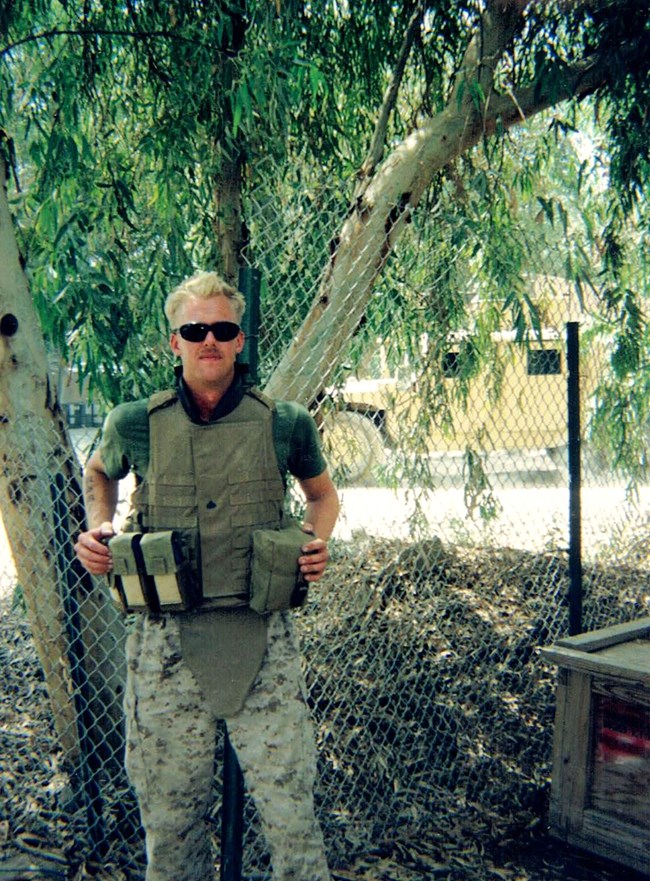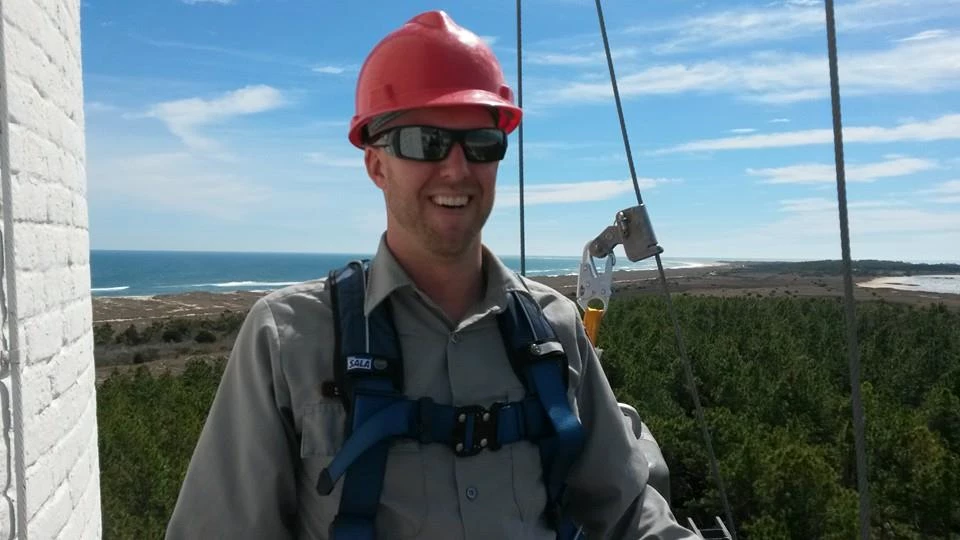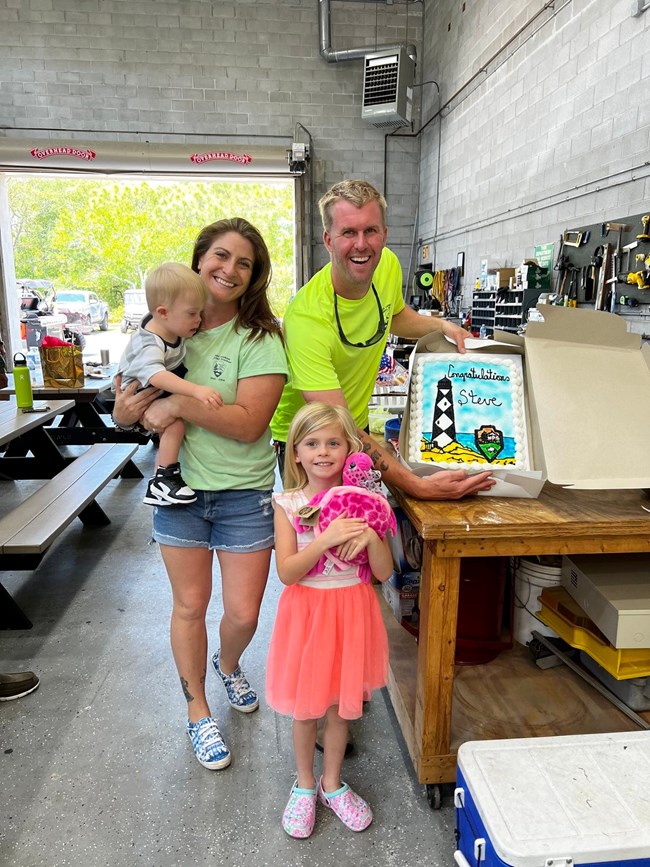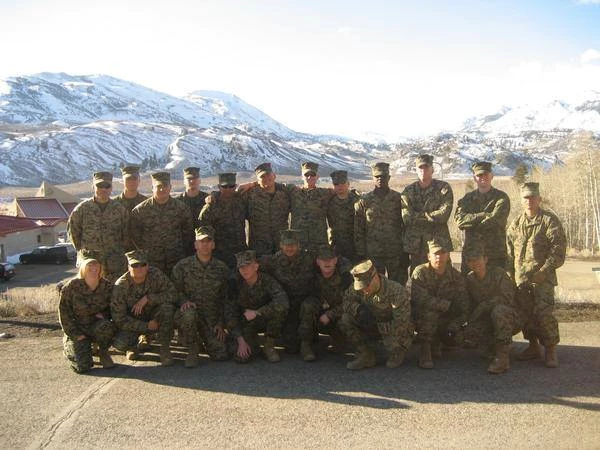Last updated: December 13, 2023
Article
Beyond the Battlefield, How a Marine's Values Shape Historic Preservation at the National Park Service
Steve Sabol, NPS Great American Outdoor Act, Maintenance Action Team Coordinator for the Southeast Region

NPS
Can you share a bit about your military service and what led you to join the National Park Service?
I served active duty in the United States Marine Corps from 2003-2007. I served as a heavy equipment mechanic with 7th engineer support battalion in Camp Pendleton California and I deployed to Iraq in 2006. I built friendships and life experiences in those 4 years that would shape the remainder of my life. After the Marines I worked for a diesel pump company in Pennsylvania for 5 years. In 2013 I was seeking a new opportunity, something more rewarding and exciting. I relocated to North Carolina when I was selected for a position at Cape Lookout National Seashore as a work leader. From there I went on to Work Supervisor, and eventually parted ways with CALO as Acting-Facility Manager.
How did your military experience prepare you for a role at the National Park Service, especially in terms of skills and values?
The Marine Corps always found a way to provide opportunities to “think outside of the box”. Adaptability and problem solving were two traits that I exercised regularly. Finding ways to accomplish tasks, usually without enough resources was a regular part of my job. Two values that I relied on heavily were dependability and integrity. In the marine corps, those around you counted on you and put a lot of value in your word. Today I still bring that same level of dependability and integrity to the National Park Service.
Many veterans bring a diverse set of skills to their work. Can you highlight a particular skill or experience from your military service that you find especially valuable in your current role?
Task prioritization and efficiency are 2 skills that I have leaned on from my Marine Corps time until present day. The ability to realize what needs to be done now, versus what can wait, and then determining the fastest way to end up with a quality product. Still handling business like that today allows for planning and sequencing that a new program requires. I did not walk into a well-oiled machine 18 months ago in the MAT program, I walked into a vision. A vision that I very quickly had to turn into a functioning portfolio of projects. Thankfully I’m also surrounded by like minded individuals, both in the Southeast region FSD and HPTC.
What preservation projects have you been involved in at the National Park Service, and how do you feel your work contributes to the broader mission of the NPS?
During my time at Cape Lookout, I was responsible for projects at Portsmouth Village and Cape Lookout Village. We accomplished day-labor and contracted projects on the life saving station, coast guard station, historic Portsmouth village church, and countless historic residences. Now I’ve taken that field experience to the regional level where I work directly with parks to identify work on historic structures, our national cemeteries, and cultural assets. These projects are developed from concepts or ideas, scoped by HPTC subject matter experts, and eventually the work is completed by a Maintenance Action Team. So, while I’m not in the field or hands on much anymore, the scope of impact has grown to a point that I’m often in amazement when a project leader sends me a completion report of a project that 12 to 18 months ago was only an idea.


Can you share a particularly proud or rewarding moment you've experienced while working on a preservation project?
The most rewarding part of my current duties revolves around our National Cemeteries, battlefields, and forts. The gravity of these locations and the significance that each holds makes me reflect on what took place there and the importance of preserving that story. All of those that call our national cemeteries their final resting place and the scenes that took place on the battlefields, those are why these places are important. It is because of those lives lost and the acts that took place on those sites, why our roles are so vital. That history needs to be preserved and the stories need to be told. To do that, those locations must be returned to excellent condition.
The NPS has a diverse range of roles. Can you describe how your current position allows you to apply different aspects of your background and expertise?
My current position as a coordinator and program manager for the southeast region isn’t where I thought I’d be honestly. If you asked me 5 years ago where I would be, it wouldn’t be managing project creation and execution by teams of trades people from hundreds of miles away. I always felt that my skills and abilities suited me best as a working supervisor, someone in the field working directly with staff to accomplish a project. Those are some of my favorite memories at Cape Lookout, working with the maintenance team to rebuild a dock or deck, knocking out a siding or window project in record time, helping to run new water and electrical lines after hurricane Florence. But on the flip side of that coin is the logistics and planning required to make projects like that successful, and it turns out those are the skills that got me where I am today. So, while my position has changed greatly, I’m still using the same toolbox of skills.
Preservation projects often have a positive impact on local communities. How do you see your work contributing to community well-being?
MAT and historic preservation impacts apply both to the visitor experience and the youth that we reach through project execution. The majority of MAT and NCII projects are very polarizing; high visitation, forward facing park assets. Upon completion of the project, a visitor is very easily able to see the impact our work is having on their experience. The often-unrealized benefit that these projects have is our ability to incorporate youth through TTAP and Youth Corps placement on many of these projects. Those skills and experiences are absorbed by those corps members and brought back to their families and friends, furthering the community outreach in a way that can’t be quantified.
As we approach Veterans Day, what would you like the public to know or understand about the contributions of veterans working in the National Park Service?
From my NPS relationships and experiences, most Veterans contribute to the NPS mission because we believe in it. We believe in continuing to preserve what we once protected. The expectations are high, and the challenges are rewarding, very similar to the Armed Forces. For those reasons it is my personal belief that Veterans make some of the very best National Parks Service employees.

